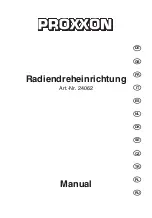
CREATING STRAIGHT BEADS
IMPORTANT
NOTE:
For the greatest ease in handling workpiece
panels and achieving optimal accuracy in forming beads, it is
strongly advised to have a helper turn the handle as you work.
• Have the helper crank slowly as you move the metal along
following your marked guideline
(Fig I)
.
• Keep the marked guideline aligned with the center of the Upper
Female Mandrel Die groove as you go. When you reach the end of
the guideline, you may re-roll the bead by having your helper turn
the crank in the opposite direction. This produces a more sharply
defi ned bead.
•
When done, loosen and retract the Roller Tensioning Bolt then loosen
the Upper Bearing Block bolts located at the rear of the Bead Roller
Frame with a 19mm wrench (not included).
• Pull the workpiece panel from between the dies and admire your
work.
FORMING CURVES
• The trick to forming curves with the bead roller is careful
coordination between your helper cranking the handle, and you
moving the metal workpiece slowly through the dies while turning
it through the curve all at the same time.
• It is critical to producing a good job that you keep the guideline
aligned with the center of the Upper Female Mandrel Die groove as
you go
(Fig J)
. If your design forms an oval, start the bead in the
center of a straight or larger radiused section.
• Do no attempt to start right at a corner or a joint of two lines, since
it will be extremely diffi cult to line up the bead perfectly when you
fi nish.
• By using combinations of curves and straight lines, there is almost
no limit to the designs you can create with the Eastwood Bead
Roller.
Fig. G
Fig. G
Fig. H
Fig. H
Fig. I
Fig. I
Fig. J
Fig. J

















